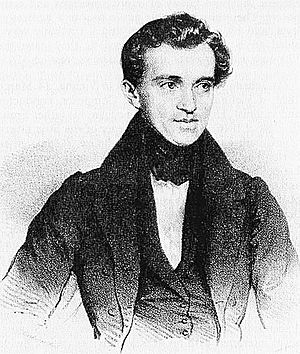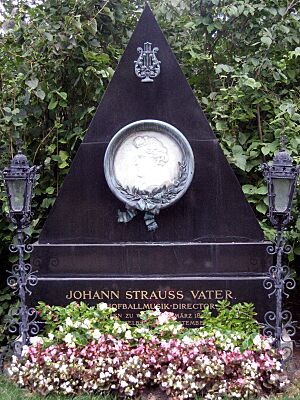Johann Strauss I facts for kids
Johann Baptist Strauss I (born March 14, 1804 – died September 25, 1849) was an important Austrian composer. People also called him Johann Strauss Sr. or the Father. He was famous for his light and fun music, especially waltzes, polkas, and galops. He helped make these dances very popular. His three sons, Johann, Josef, and Eduard, followed in his footsteps and became famous musicians too. Johann Strauss I is best known for his exciting piece, the Radetzky March.
Contents
Life and Music Journey
Johann Strauss was born in a part of Vienna called Leopoldstadt. His parents, Franz Borgias Strauss and Barbara Dollmann, ran an inn. As a young boy, Johann was placed with a tailor named Anton Müller. He became an apprentice to a bookbinder, Johann Lichtscheidl. Even while learning bookbinding, Johann also took lessons to play the violin and viola. He finished his bookbinding apprenticeship in 1822.
Starting in Music
Johann also studied music with Johann Polischansky. Soon, he joined a local orchestra led by Michael Pamer. Later, he left that group to join a popular string quartet. This quartet was called the Lanner Quartet, and it included Joseph Lanner. They played Viennese waltzes and German dances. By 1824, this quartet grew into a small string orchestra.
Strauss became the assistant conductor for Lanner's orchestra. It became very popular, especially during the Carnival season in 1824. Soon, Strauss was put in charge of a second, smaller orchestra. In 1825, he decided to start his own band. He began writing his own dance music for his band to play. He wanted to be as successful as Lanner and solve his money problems. This made Lanner his rival, but their friendly competition helped the waltz and other dance music grow in Vienna.
Becoming Famous
Johann Strauss I quickly became one of the most loved dance composers in Vienna. In 1826, his band played for the public in Vienna, and his first waltz, "Täuberln-Walzer" (Op. 1), made him famous right away. He traveled with his band to many countries, including Germany, the Netherlands, Belgium, and Britain. His sons later took over leading the Strauss Orchestra.
In 1837, Strauss visited France and heard the quadrille dance. He started writing quadrilles himself. He was a big reason why this dance became very popular in Austria in the 1840s. This trip also showed how popular Strauss was with all kinds of people. This led him to plan a big performance in England for the coronation of Queen Victoria in 1838. Strauss often used popular tunes of his time in his music to attract more listeners. For example, he used music from the Oberon opera in his waltz "Wiener Carneval" and the French national anthem "La Marseillaise" in his "Paris-Walzer."
Family Life
Strauss married Maria Anna Streim in 1825 in Vienna. Their marriage was not very happy because he was often away on tours. They had six children: Johann (born 1825), Josef (born 1827), Anna, Therese, Ferdinand (who lived only ten months), and Eduard (born 1835).
The family lived in a home known as the 'Goldener Hirsch' (The Golden Stag). Strauss was very strict. He did not want any of his sons to become musicians, even though they were very talented. He wanted Johann Junior to study banking, Josef to join the military, and Eduard to work for the Austrian government.
By 1834, Strauss had another relationship. In 1844, his wife, Maria Anna, decided to end their marriage. After this, she strongly supported Johann Strauss II's musical career, helping him become a composer.
Musical Style and Legacy
Despite his family challenges, Strauss senior kept touring and writing new music for many events. He helped change the waltz from a simple country dance into the elegant Viennese waltz we know today. His waltzes usually had a short introduction, a few waltz parts, and a strong finish. His son, Johann Strauss II, later made the waltz even bigger and used more instruments.
Johann Strauss I was one of the first waltz composers, along with Joseph Lanner, to give his pieces individual names. This helped people recognize and buy their sheet music. He also started charging a fixed entrance fee for his performances at the Sperl-Ballroom in Vienna, instead of just collecting money from a plate.
His son, Johann Strauss II, often played his father's music and admired it. However, it was well known in Vienna that they had a strong rivalry, and the newspapers often wrote about it. Johann Strauss I refused to play at the Dommayer's Casino after his son made his conducting debut there. During his lifetime, Johann Strauss I was more successful in his career than his son. But later, Johann Strauss II became even more famous in classical music. In 1846, Emperor Ferdinand I gave Johann Strauss I the special title of Director of Music for the Imperial and Royal Court Balls.
Johann Strauss I died in Vienna on September 25, 1849, at the age of 45. He caught scarlet fever from one of his children. He was buried next to his friend Joseph Lanner. In 1904, their remains were moved to special graves of honor at the Zentralfriedhof (Central Cemetery) in Vienna. The old cemetery where they were first buried is now a park named Strauss-Lanner Park. The famous composer Hector Berlioz once said that "Vienna without Strauss is like Austria without the Danube," showing how important he was.
The guitarist Nita Strauss, who plays with Alice Cooper, says she is a descendant of Johann Strauss.
Works
Waltzes
- Täuberln-Walzer, Op. 1 Little Doves (1827)
- Döblinger Réunion-Walzer, Op. 2 Dobling Reunion Waltz
- Wiener Carneval, Op. 3 Viennese Carnival (1828)
- Kettenbrücke-Walzer, Op. 4 Suspension Bridge (1828)
- Gesellschafts-Walzer, Op. 5 Association’s Waltz
- Wiener Launen-Walzer, Op. 6 Vienna Fancies Waltz
- Tivoli-Rutsch Walzer, Op. 39 Tivoli-Slide (1830)
- Das Leben ein Tanz oder Der Tanz ein Leben! Walzer, Op. 49 Life is a Dance
- Elisabethen-Walzer, Op. 71
- Philomelen-Walzer, Op. 82
- Paris-Walzer, Op. 101 (1838)
- Huldigung der Königin Victoria von Grossbritannien, Op. 103 Homage to Queen Victoria of Great Britain
- Wiener Gemüths-Walzer, Op. 116 Viennese Sentiments (1840)
- Loreley-Rhein-Klänge, Op. 154 Echoes of the Rhine Loreley (1843)
Galops and Polkas
Some of Strauss's galops and polkas include:
- Champagner-Galopp, op. 8
- Seufzer-Galopp, Op. 9 Sighing
- Chineser Galopp, Op. 20 Chinese
- Einzugs-Galopp, Op. 35 Entrance Galop
- Sperl-Galopp, Op. 42
- Zampa-Galopp, Op. 62
- Fortuna-Galopp, Op. 69
- Jugendfeuer-Galopp, Op. 90 Young Spirit
- Cachucha-Galopp, Op. 97
- Carneval in Paris, Op.100
- Indianer-Galopp, Op. 111 Red Indian Galopp
- Sperl-Polka, Op. 133
- Annen-Polka, Op. 137 (This is different from his son's Annen-Polka, Op. 117, from 1852)
- Wiener Kreutzer Polka, Op. 220
- Piefke und Pufke Polka, Op. 235
Marches
- Radetzky-Marsch, Op. 228 (1848)
- Jelačić-Marsch, Op. 244
See also
 In Spanish: Johann Strauss (padre) para niños
In Spanish: Johann Strauss (padre) para niños
- The Strauss Family, a TV show
- List of Austrians in music
- Strauss Museum Vienna




